According to the U.S. Office of Disease Prevention and Health Promotion (ODPHP), practitioners diagnose an estimated 20 million new cases of sexually transmitted infections (STIs) each year, with roughly half of those in patients under age 25.
As these statistics continue to trend upward, this may be just the tip of the iceberg: Common STIs do not always come with symptoms, and many patients may not know they are infected. This can have lasting consequences on reproductive health, particularly for women.
Understanding Fertility, Pregnancy and STIs
Undiagnosed STIs lead to at least 24,000 cases of infertility annually, the ODPHP adds. However, not all infections can cause problems of the same severity.
Though many STIs may not cause lasting fertility issues, they can still lead to prenatal or postnatal risks. For example, human papillomavirus and genital herpes are quite common; there is limited evidence that either virus has a long-term effect on fertility, but they can come with pregnancy or delivery complications.
On the other hand, there are two common STIs that can cause lingering fertility problems for female patients, according to the Centers for Disease Control and Prevention (CDC):
- Chlamydia, which affects an estimated 2.86 million people each year.
- Gonorrhea, which affects an estimated 820,000 people each year.
Without treatment, both of these bacterial infections can lead to pelvic inflammatory disease (PID) and ultimately cause permanent scarring or occlusion in the fallopian tubes. This structural damage raises the risk of tubal factor infertility, a fairly common cause of female infertility. PID can also increase the risk of ectopic pregnancy and preterm labor.

Navigating STIs and Tubal Factor Infertility
Though the American College of Obstetricians and Gynecologists and the American Society for Reproductive Medicine recommend collecting STI history during infertility workups, many patients may not know they have gonorrhea, chlamydia or PID.
As "silent" infections, gonorrhea and chlamydia can go undetected when asymptomatic. Additionally, most experts do not recommend screening for low-risk women over age 25. As a result, fertility specialists may need to combine lab testing with ultrasound imaging to reveal previously undiagnosed issues from months or even years back.
- Lab Testing: The latest CDC recommendations for suspected STIs suggest taking a NAAT vaginal swab for women to test for chlamydia, and either culture (cervical swab) or NAAT (cervical swab, vaginal swab or urine) to test for gonorrhea.
- Imaging: To assess tubal integrity, ultrasound can provide optics into structural problems through hysterosalpingo-contrast sonography. This procedure involves moving fluid through tubal channels to check for blockages.

3D HyCoSy exam demonstrating a single patent fallopian tube
Does STI History Preclude IVF Treatment?
In most cases, patients with a history of common STIs are still able to undergo in vitro fertilization (IVF). However, before initiating an IVF treatment plan, patients should have a cervical swab to test for active gonorrhea and chlamydia, advises the Society for Assisted Reproductive Technology. Active gonorrhea and chlamydia infections pose prenatal and postnatal risks and may require delaying IVF cycles until the infections are resolved. Clinicians should remind these patients, who may be frustrated or embarrassed, that gonorrhea and chlamydia are both common and curable.
For patients with prior STIs that have since led to PID and tubal damage, IVF may still be a suitable option, potentially in tandem with another treatment. Depending on the extent of tubal impairment visible on ultrasound, surgical repair may be necessary for some patients with tubal factor infertility.
Ultimately, these findings mean that patients have opportunities for positive outcomes related to their fertility, pregnancy and STIs. The earlier you can detect potential issues for your patients, the better. Use imaging tools such as ultrasound to monitor and protect tubal patency as well as overall reproductive health.




